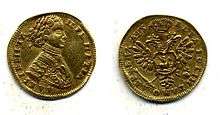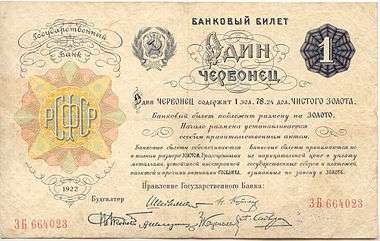Chervonets
Chervonets (Russian: Черво́нец; plural chervontsy or chervontsev) is a former currency of the Russian Empire and Soviet Union. Originally a term for coins of purer alloy (the name derives from "червонное золото" ("chervonnoye zoloto") meaning pure gold), the name was later applied to various sums in Russian rubles.
Pre-revolutionary chervonets

The term comes from Polish czerwony złoty. Before the reign of Peter I, the name chervonets was applied to various foreign gold coins in circulation in Russia, mostly Dutch ducats and sequins. In 1701, Russia introduced its own gold chervonets, which had the same mass (3.47 g) and alloy (.986) as the ducat. Unlike the gold coins minted in Russia from the 15th to the 17th centuries, which were used as awards only, the chervonets of Peter I took their place in the monetary system and were used in foreign trade. Chervontsy were minted until 1757, when they were displaced by the golden ruble (with a lower alloy) and by counterfeits of the Dutch ducat, which by then met the demand for trade in gold coins.
Under Nicolas II, the finance minister Sergei Witte conducted a currency reform [1] and 10 ruble gold coin (Nicolas II chervonets) started to be used in parallel with gold imperial (15 ruble gold coin) as a principal legal tender of the Russian golden standard. The mintage of 10 ruble coins in 1897−1911 was over 40 million pieces. Gold coins were in circulation and could be exchanged for banknotes of the same denomination without restrictions. On the 23 July/ 5 August 1914 a paper-to-gold exchange was suspended "temporarily" and never restored.
Soviet Union
New Economic Policy (NEP)

In 1922, during the civil war, the Soviet government tried to enforce Communist economic ideals and eliminate debt through systematic devaluation of the ruble and its associated currencies (various forms of Imperial ruble, kerenki and later sovznaki).[2] Meanwhile, the authorities introduced a parallel currency, called the chervonets, which was fully convertible and backed by the gold standard. The chervonets existed in paper form (for domestic circulation) and as gold coins (for international payments). These coins contained 8.6 g of .900 alloy, and fetched a high rate on the foreign stock exchanges, allowing the financing of the Soviet Union's New Economic Policy. 2,751,200 coins with the year 1923 on the reverse were minted in 1923 (1,113,200 pieces) and 1924 (1,638,000 pieces).
With the creation of the Soviet Union (USSR) new national symbols were introduced, and one would expect to see this reflected in the design of Soviet coins. By February 1925, chervonets coins featuring the insignia of the Soviet Union had been designed, and a limited number of test coins dated 1925 were struck. However these were not mass-produced owing to low perceived demand for them from the main international trading partners of the Soviet Union.
Original gold chervonets coins were minted in 1923 and 1925. Very few chervonets coins remain from 1923 (almost all coins, which were not sold abroad and remained in state vaults, were recast into bars or used in production of Soviet military orders) and they have recently sold for over $7000. There is widespread misconception about the 1925 issue: all English sources copy each other and say that only one gold chervonets from 1925 survived, but this is not entirely true. At an auction in April 2008 in Moscow, a single surviving production sample copper chervonets from 1925 with slightly modified design from 1923 appeared. It showed the letters SSSR (Russian: СССР) instead of RSFSR (Russian: РСФСР), and introduced a new coat of arms (which only featured the first seven Soviet republics, whereas by 1939 the USSR had 15). This copper sample sold for $200,000.
After the introduction in the United Kingdom of the Gold Standard Act 1925,[3] which established a new procedure for buy-sell operations with gold, the gold coins issued after 1914 ceased to be accepted by the Bank of England. As a result, interest in the Soviet chervonets in Europe fell sharply. To obtain much-needed foreign currency, the Soviet Government decided to strike 10 ruble coins in the pre-revolutionary design, bearing the portrait of the murdered tsar Nicholas II. These coins were accepted without problems. 600,000 gold 10 ruble coins were struck in 1925 from the old dies which had survived the 1917 Revolution and the subsequent civil war. These coins were dated 1911. The following year, 1926, the government minted a further 1,411,000 of the same coins, as well as 1,000,000 gold 5 ruble coins dated 1898 on the reverse and again with the portrait of Nicolas II on the obverse. The transition of the European currency system in the second half of the 1920s to a gold bullion standard led to a minimum volume requirement of 400 troy ounces for inter-bank gold deals. This resulted in the increased use of bullion bars and rendered it pointless to mint precious metal coins for international payments. A part of residual coins with the tsar portrait was used by Soviet intelligence agents in secret operations abroad.
Before industrialisation the value of the chervonets was pegged at 10 rubles, and production of gold coins ceased.
In 1930 chervonets was withdrawn from the foreign payments turnover and its quotation on international currency exchanges was ceased.[4]
As of today, there exist five known gold chervontsy from 1925. All are located in Moscow. Three are stored in the museum of Goznak, Russia's official mint. The other two are in the Pushkin State Museum of Fine Arts.
1930s and later


.
In 1937 1, 3, 5, 10 chervonets banknotes in new design were issued, and Lenin's portrait first appeared on chervonets banknotes. But inscription on gold equivalent of chervonets was replaced with information that banknotes are backed with gold, precious metals and other assets of the State Bank.
The chervonets was suspended entirely after the monetary reform of 1947. However a large number of golden chervontsy were struck in the 1920s design before the 1980 Summer Olympics in Moscow, for sale to collectors (1,000,000 coins of proof quality dated 1980) and businesses (6,565,000 uncirculated coins, dated 1975 - 1982[5]). It was hoped that the Soviet chervontsy would compete with the South African Kruggerand, the popular bullion coin of the time. This issue contains 8.6026 g of .900 fine gold (0.2489 troy ounces). [6]
In 1995 the Central Bank of the Russian Federation launched sales of 1975−1982 gold chervonets bullion coins to Russian commercial banks. In 2001 the late Soviet gold chervonets was granted the status of a legal tender by the Central Bank and turned into an official investment coin. In the middle of the 2000s the stock of gold chervonets in the Central Bank's vaults came to the end, and a minting of a new investment gold coin, Saint George the Victorious, was started in 2006.
See also
Footnotes
- ↑ Count Sergei Witte and the Twilight of Imperial Russia: A Biography
- ↑ Nenovsky, Nikolay (2006). "Lenin and the currency competition: reflections on the NEP experience 1922–1924 (ICER Working Paper 22/2006)" (PDF). Turin: International Centre for Economic Research.
- ↑ The Heyday of the Gold Standard 1820−1930
- ↑ The State Bank of the USSR
- ↑ Investment Coin One Chervonets Archived January 29, 2013, at the Wayback Machine.
- ↑ Gold Russian Chervonetz
External links
| Wikimedia Commons has media related to Chervonets. |
- Монеты России и СССР
- http://www.numizmat.net/news/detail.php?ID=9876 (Russian website)
- 1 Chervonets 1937